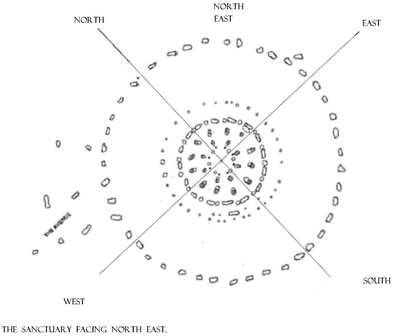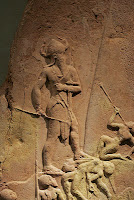The Seven Hills.
Last time I was in Avebury I couldn't leave the shop without buying Avebury -the biography of a landscape by Joshua Pollard and Andrew Reynolds. I knew that Joshua Pollard and Mike Pitts had excavated The Sanctuary in 1999 and so I was looking forwards to reading something about the place from someone who had actually dug into it.
So, date:
The site of The Sanctuary has been in use since the Neolithic, but the 'integrety of the plan of the monument strongly suggests the posts belong to a single-phase construction, though perhaps with the stone setting coming a little latter' (Pollard 1992). Finds within the post holes: chiseled arrow heads, sherds of Grooved ware give a date of approximately 2500 BC.
Function:
Trying to work out what actually happened there is a challenge. The objects found in the post holes were recorded by the Cunningtons: the large stones were erected with offerings of Grooved ware bowls and unused arrowheads. Niedermendig lava (elsewhere described as being from a grinding stone, a quern) was placed in one hole.
The lava was placed in C7. and a horse metacarpal, in E2.
As to finds not buried with the posts or stones:
The Eastern side of The Sanctuary is the area with most deposits. The entrance area, 'kept clean'.
A large quantity of debris from the work of shaping the stones accumulated around the posts and stones of ring C in the SE quarter, and a human mandible was found here.
The stone C12 that marks the position of the girl buried east of center in the circle.
If you were standing, looking towards the center of the circles, back to the single, out lying stone, you would be facing NE.
What did surprise me was this statement (page 176):
The reason why this surprises me (other than obviously I thought that the barrows were all Bronze Age) is that in the 20th and 21st century people have their ashes cast into the sea and rivers (fired into space), scattered onto football grounds, or heated and compressed in to diamonds, or pressed into vinyl. We don't generally use other people's sacred sites, we find places that are sacred to us.
There is an area around the crematorium which is I guess, general 'sacred ground' (no rules about kind of religion, or denomination) but 'we' don't generally use 'native' sites, or copy 'native' practices.
'We' don't expect other people to want to copy 'us' either. The crematorium likewise is primarily utilitarian, it fulfills the law, rather than dictates of a religion.
If it wasn't too confusing to let people scatter their loved one's ashes in Stonehenge, and illegal to build a 'Tower of Silance' in parkland or garden, if one could employ Chodpas (and import the vultures) would 'we'?
Perhaps it was a rare occurrence in Roman times. But some of the Romans at least, who found themselves in sunny Albion, in their construction of barrows made a positive choice. It wasn't 'make-do' or the 'only' possible solution.
So, date:
The site of The Sanctuary has been in use since the Neolithic, but the 'integrety of the plan of the monument strongly suggests the posts belong to a single-phase construction, though perhaps with the stone setting coming a little latter' (Pollard 1992). Finds within the post holes: chiseled arrow heads, sherds of Grooved ware give a date of approximately 2500 BC.
Function:
Trying to work out what actually happened there is a challenge. The objects found in the post holes were recorded by the Cunningtons: the large stones were erected with offerings of Grooved ware bowls and unused arrowheads. Niedermendig lava (elsewhere described as being from a grinding stone, a quern) was placed in one hole.
Lava from the Niedermendig–Andernach–Eifel region of the Rhineland widely used in making querns and grinding stones from the later Neolithic onwards. The quality of the stone is such that it was traded widely in northern Europe.Querns made of this stone were traded in Saxon times, used in the Roman period for the same purpose; a rough stone - millstone grit.
The lava was placed in C7. and a horse metacarpal, in E2.
As to finds not buried with the posts or stones:
The Eastern side of The Sanctuary is the area with most deposits. The entrance area, 'kept clean'.
A large quantity of debris from the work of shaping the stones accumulated around the posts and stones of ring C in the SE quarter, and a human mandible was found here.
The stone C12 that marks the position of the girl buried east of center in the circle.
If you were standing, looking towards the center of the circles, back to the single, out lying stone, you would be facing NE.
What did surprise me was this statement (page 176):
"Rather more spectacular are the unusual Roman barrow burials on Overton Hill excavated in 1962 opposite the Sanctuary...The Overton Hill cemetery had long been thought to be typical of the Early Bronze Age...characterised by barrows arranged in lines. The 1962 excavations, however, showed that three of the mounds were in fact of the Roman period, they are known by archaeologists as West Overton G6, G6a and G7 from south to north; the 'G' prefix refers to the near exhaustive listing of Wiltshire barrows by the Rev. Goddard and, later, Leslie Grinsell."
The reason why this surprises me (other than obviously I thought that the barrows were all Bronze Age) is that in the 20th and 21st century people have their ashes cast into the sea and rivers (fired into space), scattered onto football grounds, or heated and compressed in to diamonds, or pressed into vinyl. We don't generally use other people's sacred sites, we find places that are sacred to us.
There is an area around the crematorium which is I guess, general 'sacred ground' (no rules about kind of religion, or denomination) but 'we' don't generally use 'native' sites, or copy 'native' practices.
'We' don't expect other people to want to copy 'us' either. The crematorium likewise is primarily utilitarian, it fulfills the law, rather than dictates of a religion.
If it wasn't too confusing to let people scatter their loved one's ashes in Stonehenge, and illegal to build a 'Tower of Silance' in parkland or garden, if one could employ Chodpas (and import the vultures) would 'we'?
Perhaps it was a rare occurrence in Roman times. But some of the Romans at least, who found themselves in sunny Albion, in their construction of barrows made a positive choice. It wasn't 'make-do' or the 'only' possible solution.


